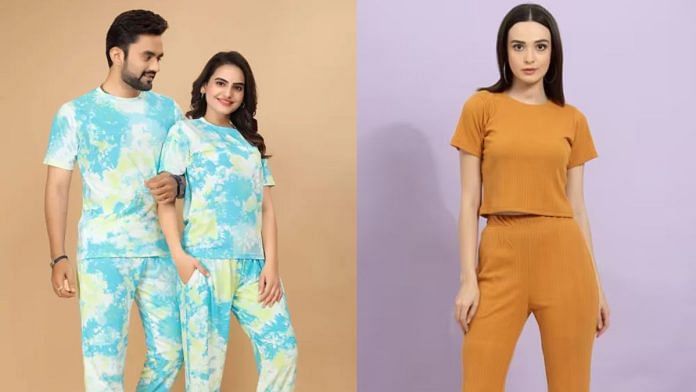If there is one thing that unites West Delhi and South Delhi, it is the ‘co-ord set’ that looks almost like a night suit. Let’s be more specific. It is the Millenials’ nightie. It is a big blob of nothing masquerading as fashion. You’ll find the hideous and outlandish cross between pantsuits and salwar kameez everywhere—on airports and even on honeymoons, often paired with choodas.
The co-ord set has infiltrated every market in the city—Janpath, Sarojini Nagar to the M block market in Greater Kailash. Some stores only sell co-ord sets—which, in many such establishments, are sold as ‘cord sets’.
I have to give it to the unnamed originator. The idea is quite good (in principle). Voluminous linen co-ord sets in summery colours really make for comfortable outfits in a hot and humid country like India. They also suit every body type, a perfect choice for women who generally steer clear of pants. But somewhere, en route to mass distribution, someone ruined them. Who let Wassily Kandinsky loose on co-ord sets now? Linen and cotton turned to satin, and soothing colours gave way to those that cause near-colourblindness. We are bang in the middle of a fashion revolution no one ever needed.
Co-ords aren’t new
To be fair, like most other ‘it’ fashion moments, co-ords are a borrowed concept. Matching outfits have been around since the 17th century, when European men started wearing coordinated doublet and hose combos.
Come 20th century, Coco Chanel popularised a comfy jersey cardigan and skirt set. In the 1950s and 1960s, colorful co-ord sets with bold prints followed, and in the 1980s and 1990s, tracksuits became all the rage.
Closer home, the likes of Zeenat Aman and Parveen Babi have also sported such outfits. Fitted shirts paired with wide belts and high-waist pants to accentuate curves while keeping it sleek and modest were a regular feature in the 1970s.
Now co-ord sets also mean skirts and tops, or tops and shorts—basically anything that’s the same colour and design. Like most women’s wear, they are often devoid of pockets, and shapeless instead of comfortable. They have spread faster than the recent pandemic we like to feign amnesia about.
Also read:
Kitschy or curtain-y?
What co-ord sets could have symbolised has been drowned in an avalanche of meaningless products. Of course, they could have made Western fashion more inclusive of and available to women whose bodies don’t meet Eurocentric standards. But the outfits themselves look like someone forgot mid-stitch what exactly they were designing.
It gets even worse in plus sizes, where the designs are almost like pity offerings. They seem to tell big women that they should be grateful for the fact that co-ords are available in their sizes. The silhouettes are appalling, and the prints more so. There is a fine line between kitschy and curtain-y, and co-ords are often the latter.
If we call out runway fashion for its absurdity, the co-ord set must also be criticised for its absolute lack of cohesion. It may be ‘in’ but it is definitely not cool anymore. If Instagram trends are icky, co-ord sets are more so. Influencers promoting the fashion nightmare at least get paid for the 30 seconds they have to put up with it. Others have to live with the fact that they bought – and even wore – such disastrous pieces of clothing.
Views are personal.
(Edited by Zoya Bhatti)






